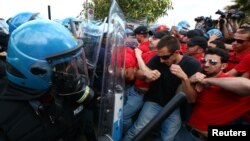A group of protesters sought to break through a police cordon at the end of a protest march against world leaders meeting on the island of Sicily on Saturday, scuffling with security forces, who fired tear gas to disperse them.
After hundreds of people had peacefully marched through the streets of the seaside town of Giardini Naxos, down the hill from where a Group of Seven meeting had been held, a smaller group of about 100 people peeled off from the pack and challenged riot police.
When they tried to flank them by running along the beach, police charged and fired tear gas. Protesters washed their eyes out with water and an ambulance appeared to take away at least one injured person.
Italy had massive security measures in place for the protesters who accused world leaders of ignoring the interests of ordinary people.
Though some 3,500 were expected to turn up, the actual turnout appeared to be about half of that.
Salvatore Giordano, a Sicilian high school professor, blamed the low turnout of in part on heavy security. He was stopped by police multiple times and blocked for a half-hour at the highway exit before finally being let through. Police were also stopping buses and searching them, he said.
"They are criminalizing our dissent," Giordano said. "We're pacifists. We're not here to break windows, but to protest against Sicily being turned into a giant aircraft carrier for the world's military powers."
"CAMPAIGN OF FEAR" U.S. President Donald Trump and the heads of Italy, France, Britain, Germany, Canada and Japan had been meeting in Taormina, which sits on a rocky hilltop just north of Giardini Naxos.
Bus loads of police lined the route of the march in what is normally a sleepy town of beach-going tourists, while a police helicopter circled above.
Giordano came to air his opposition to the Mobile User Objective System (MUOS), part of an ultra-fast satellite communications network for the American military that he says poses a health risk to people living near the infrastructure.
Another group of protesters carried red flags bearing the communist hammer and sickle symbol.
Alessandro D'Alessandro, the coordinator of Sicily's communist party, said there had been a media campaign of fear against the protesters, which kept numbers low.
"It was hard to get here," D'Alessandro said. "But we came to tell the world's most powerful people that we oppose their military and capitalistic worldview. We're here to defend the interests of the weakest."
Fears of violent protests like the ones seen during a G7 summit in the northern Italian city of Genoa in 2001 prompted the mayor of Giardini Naxos to order all local businesses to close for the day.
Sixteen years ago throngs of protesters in Genoa clashed with authorities in street battles spread out over two days, and police shot dead an anti-globalization protester during some of Italy's worst-ever riots.








